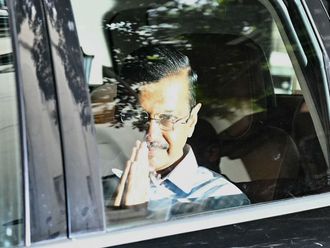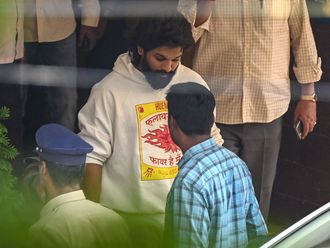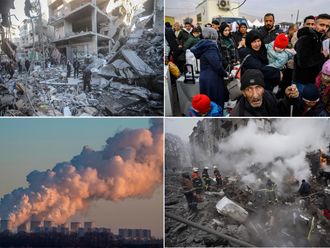
Last Thursday, a surprisingly low-profile meeting took place at the Black Sea resort of Sochi between Russian Foreign Minister Sergei Lavrov and his Jordanian counterpart, Ayman Safadi. It was mostly overshadowed by the Lebanese parliamentary elections on Sunday and the ongoing battles in the Palestinian refugee camp of Yarmouk in Syria. Freed from the burdens of media exposure, the two top diplomats discussed the Syrian crisis ahead of Russian and Syrian plans to march south towards the border with Jordan, once finishing off the last rebel pockets around Damascus.
The decision to head south is mainly a Russian one, whereas the Syrians would have preferred advancing towards Idlib in the Syrian northwest, where 13 Turkish checkpoints stand, along with a variety of Islamist groups, headed by Hayat Tahrir Al Sham, formerly known as Jabhat Al Nusra. A military operation was started there, but left incomplete when troops were suddenly summoned to the Damascus countryside to start the East Ghouta offensive last February. Moscow thinks that Idlib can wait, wanting to clear it first with the Turks, who are their allies in the Astana Process. For now, full attention is on the southern front, which is vital for the United States due to its proximity with Israel. Already, 600 Russian military police have been stationed there since late 2017 and the Kremlin hopes to double their size by next summer — unilateral action, no doubt, done in the total absence of US diplomacy in the Syrian crisis.
A ceasefire for the Syrian south was originally agreed upon between US President Donald Trump and Russian President Vladimir Putin at the G20 Summit in Hamburg last July. All territory from Syria’s borders with Jordan and Israel up to the countryside of Suwaida in the Druze Mountain, was officially incorporated into the “de-conflict zones” formula, agreed upon at Astana between Turkey, Russia, and Iran. All non-Syrian combatants were to be pushed away from the border, in reference to Hezbollah, of course, and to the local branch of Daesh, known as the Khalid Bin Al Walid Army. Israel did not seem to mind the agreement, sending its aircraft to strike at supposed Iranian bases and weapons in the Syrian south, at least six times since last September. They were never halted or prevented by the Russians and likewise, neither the US nor the Jordanians lifted a finger to save Syrian rebels in the Daraa countryside, pounded by the Russian Air Force.
According to the now obsolete agreement, Syrian rebels would surrender their heavy arms and keep their light arms, using them to police and protect their villages and towns from Daesh and its affiliates. The Syrian government would get to raise its tri-colour over the strategic city of Daraa and reopen schools and police stations, promising neither to arrest nor harass any of the residents who took up arms since 2011. That agreement never saw the light and it technically expired in November 2017, only to re-emerge at the Sochi Summit last Thursday.
The Russians are revisiting the proposal, only with several amendments. One is to confiscate all arms, both light and heavy, from the armed opposition and to make them choose between staying behind and surrendering or heading in green buses to Idlib, under the watchful eye and protection of the Russian Army. Staying in Daraa and simultaneously keeping their arms is now off-limits, by Russian standards. Top Russian negotiators feel they are in a far better position to negotiate and impose their will after crushing the opposition in Eastern Ghouta, seeing that apart from lip service, the US neither came to their aid nor lifted a finger to protect them.
Exact opposite
When the Russians entered the Syrian battlefield in September 2015, many wrongly predicted that they were there to regain every inch of territory, refusing to share war-torn Syria with any of the main stakeholders. The exact opposite happened, as the Russians cut deals with almost every player in the Syrian patchwork, based on one golden rule: ‘No Trespassing; I stay out of your territory and you stay out of mine!’ On the northern border, they looked the other way as Turkish forces invaded and occupied strategic towns like Jarablus and Azaz, and then went inwards overrunning Al Bab and more recently Afrin. They are now laying claim to Manbij, west of the Euphrates River, which lies deep within Russia’s sphere of influence. In exchange for doing nothing about Turkish ambitions, the Turks looked the other way as their Syrian proxies were crushed, first in Aleppo back in December 2016 and now in East Ghouta in February 2018. Rhetoric aside, the Russians have done nothing to prevent the creation of eight US military bases east of the Euphrates River — testimony to pragmatism, more so than inability. But in the Syrian south, things are different.
Too much is at stake for the Americans and the Israelis to allow one side to reign in the area. Rather, it more or less has to be restored to its pre-2011 order, demilitarised, internationalised on the Israeli front, monitored by the United Nations — with joint higher supervision by the Americans and the Russians.
Sami Moubayed is a Syrian historian and former Carnegie scholar. He is also the author of Under the Black Flag: At the frontier of the New Jihad.



_resources1_16a45059ca3_small.jpg)





